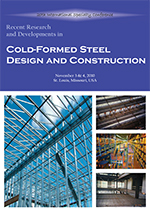Session Dates
03 Nov 2010
Abstract
This paper reviews the Component Stiffness Method for determining anchorage forces in roof systems as presen ted in Chapter 5 of the new AISI Design Guide for Cold-Formed Steel Purlin Roof Framing Systems . The four steps in the general methodology of the component stiffness method are presented. First, the development of forces requiring an chorage in purlin roof systems is discussed. Next, calculation of the stif fness of each of the components of the roof system and the procedure for distributing these forces through the system is presented. The final step, evaluation of the effectiveness of the anchors in preventing deformation of the system, is discussed. The five numerical examples relating to the compone nt stiffness method are outlined.
Department(s)
Civil, Architectural and Environmental Engineering
Research Center/Lab(s)
Wei-Wen Yu Center for Cold-Formed Steel Structures
Meeting Name
20th International Specialty Conference on Cold-Formed Steel Structures
Publisher
Missouri University of Science and Technology
Document Version
Final Version
Rights
© 2010 Missouri University of Science and Technology, All rights reserved.
Document Type
Article - Conference proceedings
File Type
text
Language
English
Recommended Citation
Seek, Michael W., "Review of AISI Design Guide for Cold-formed Steel Purlin Roof Framing Systems-component Stiffness Method" (2010). CCFSS Proceedings of International Specialty Conference on Cold-Formed Steel Structures (1971 - 2018). 2.
https://scholarsmine.mst.edu/isccss/20iccfss/20iccfss-session6/2
Review of AISI Design Guide for Cold-formed Steel Purlin Roof Framing Systems-component Stiffness Method
This paper reviews the Component Stiffness Method for determining anchorage forces in roof systems as presen ted in Chapter 5 of the new AISI Design Guide for Cold-Formed Steel Purlin Roof Framing Systems . The four steps in the general methodology of the component stiffness method are presented. First, the development of forces requiring an chorage in purlin roof systems is discussed. Next, calculation of the stif fness of each of the components of the roof system and the procedure for distributing these forces through the system is presented. The final step, evaluation of the effectiveness of the anchors in preventing deformation of the system, is discussed. The five numerical examples relating to the compone nt stiffness method are outlined.



